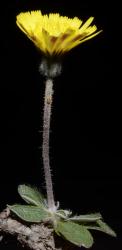- Taxon
- Weed
- Gallery
- = Hieracium pilosella subsp. micradenium Naeg. & Peter
- = Hieracium pilosella L.
- = Hieracium pilosella subsp. trichosoma Peter
Stolons slender, with numerous long simple eglandular hairs and dense stellate hairs. Rosette lvs dull glaucescent green above, white-hairy beneath, oblanceolate, sessile or shortly petiolate, entire or very obscurely dentate, (1.5)–2.5–5–(7) × 0.6–1.5–(1.8) cm, subacute and often apiculate, cuneate at base; upper surface with scattered coarse simple hairs 4–6 mm long; lower surface with fine eglandular hairs 1–2 mm long and very dense stellate hairs. Stem lf 0–(1), scale-like. Flowering stems erect, (2)–5–10–(15) cm tall, with 0-few simple eglandular hairs, numerous short glandular hairs and dense stellate hairs. Capitula solitary; involucre 8–13 mm long; bracts with dense stellate hairs and varying proportions of simple eglandular and glandular hairs. Florets yellow, often with red stripe on outer face, c. 2× length of involucre. Achenes dark, c. 2 × 0.5 mm. Pappus 5–6 mm long.
[From: Webb et al. (1985) Flora of New Zealand. Volume 4 as Hieracium pilosella L.]




